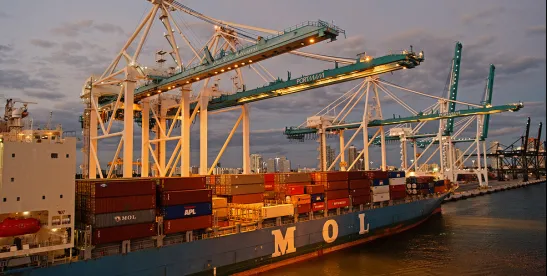Earlier this year, the U.S. Supreme Court decided Air & Liquid Systems Corp., et al. v. Devries, 139 S. Ct. 986 (2019), a maritime tort law case in which plaintiffs alleged that asbestos exposure during their Navy service caused them to develop cancer. The Supreme Court held that, in the maritime context, a manufacturer has a duty to warn not only of the manufacturer’s own products, but also of third-party products that are later added to the manufacturer’s product.
The decision set out a three-part rule. First, a product manufacturer has a duty to warn users of a third-party part when the manufacturer’s product requires that part be incorporated for the original product to work. Second, the manufacturer must also know or have reason to know that the later-incorporated part is dangerous. Finally, the manufacturer must have no reason to believe that the end users would know of the danger from the third-party product.
While the Court’s decision appears to provide a bright-line rule for products that requirethe integration of a potentially dangerous part, the decision also raises a number of questions including: 1) how courts should balance the costs of requiring warnings by different entities in the manufacturing chain, 2) how they should address the danger that overwarning consumers will lead to their disregarding warnings, and 3) if courts should consider whether plaintiffs will actually be able to recover monetary damages from potential defendants when assessing who has a duty to warn.
Background
The plaintiffs represented Navy veterans who alleged that they developed cancer as a result of exposure to asbestos on Navy ships and in naval shipyards.[1] The plaintiffs sued various equipment manufacturers even though those manufacturers’ products did not contain asbestos. Instead, asbestos-containing parts made by third parties were added by the Navy to the equipment manufacturers’ products. The plaintiffs also named the parts manufacturers as defendants, though those entities were bankrupt.[2]
At trial, the equipment manufacturers successfully argued the “bare metal defense”— that they should not be liable for third-party asbestos-containing parts that they did not make, sell, or distribute. On appeal, the Third Circuit vacated the summary judgment decision and remanded for a new trial. The Supreme Court granted certiorari to resolve a circuit split as to when product liability defendants may be held liable for injuries caused by products the defendant manufacturers did not make, sell, or distribute.
The Decision
With Justice Kavanaugh writing for the majority, the Court established a three-part test requiring manufacturers to warn of later-incorporated third-party products when the original product requires the third-party product to function. In Air & Liquid Systems Corp., the specific products at-issue were pumps, blowers, and turbines for Navy ships that required asbestos insulation and other asbestos parts in order to function.
Typically, courts applied one of three approaches to determine whether a manufacturer had a duty to warn of later-incorporated parts. The “foreseeability approach” is a plaintiff-friendly approach that requires manufacturers to warn if it was foreseeable that the later-incorporated part would be used with the original part, regardless of whether the third-party part was required for the product to function. The bare metal defense is a defense-friendly approach that limits a manufacturer’s duty to warn to the manufacturer’s product — “the bare metal” — itself. The third approach requires manufacturers to warn when the manufacturer’s product requires a third-party product to be incorporated and the manufacturer “knows or has reason to know that the integrated product is likely to be dangerous for its intended uses.”[3]
The Supreme Court adopted a middle-of-the-road approach but not one that courts have typically applied. The Court reasoned that requiring a manufacturer to warn of dangerous third-party products that were required to be integrated with the manufacturer’s product was a logical extension of the baseline rule requiring manufacturers to warn of their own dangerous products because in both situations, the manufacturer is the entity that understands the potential danger of the product(s).
Two additional factors informed the Court’s decision. First, the Court highlighted the fact that Navy service members may require special protection because they are engaged in hazardous work. Second, the Court emphasized that plaintiffs could recover only from a limited number of entities because plaintiffs had not sued the Navy and the third-party manufacturers had gone bankrupt.
Weighing the Costs
On its face, the Air & Liquid Systems Corp. opinion is limited to the maritime law context, but the opinion and dissent raise several issues that arise in non-maritime cases.
For example, the majority opinion determined that the product manufacturers were in a better position to bear the costs of additional warnings rather than the third-party part manufacturers because product manufacturers already have certain duties to warn. As the dissent noted, however, this reasoning forces product manufacturers “to internalize the full cost of any injuries caused by inadequate warnings,”[4] not only based on their own products but for third-party product manufacturers as well. It also may disincentivize parts manufacturers from making more fulsome warnings because they may rely on the product manufacturers to do so.
Further, requiring product manufacturers to warn about other manufacturers’ products also may increase consumer fatigue about warnings in general. As the dissent points out, with additional warnings on product labels, the overall effect may make “consumers less sure about which [warnings] to take seriously and more likely to disregard them all.”[5]
Finally, the Court emphasized the particular facts of this case and the inability of the plaintiffs — who alleged that they were injured as part of their service to our country — to recover from anyone except the product manufacturers. While the facts of this case were unique, the Court’s reasoning places an additional cost on product manufacturers to anticipate a future duty to warn when they manufactured their products many decades ago.
[1] Air & Liquid Systems Corp., et al. v. Devries, 139 S. Ct. 986, 991 (2019).
[2] Id. at 992.
[3] Id. at 993.
[4] Id. at 997.
[5] Id. at 998.




 />i
/>i

